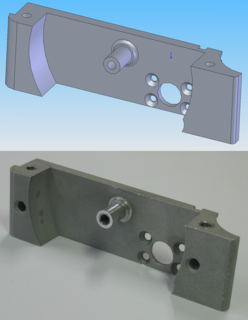Also known as the RCAM, the mission of the center is to promote and apply university led advanced manufacturing research and development work. In order to respond to the industry's needs and to provide the conditions to educate undergraduate and graduate students in the area of manufacturing
The Department of Mechanical Engineering along with SMU School of Engineering at Southern Methodist University established the Research Center for Advanced Manufacturing (RCAM) in September 1999. Activity within RCAM (Center) lies at the interface between science, engineering, and industrial practice. The Center provides the intellectual foundation for industry to collaborate with faculty and students to resolve generic, long-range challenges, thereby producing the knowledge base for steady advances in technology and their speedy transition to the marketplace.
The center is equipped with the most advanced equipment and instrumentation, and is supported by a well equipped machine shop and computing facilities. The center is housed in the J. Lindsay Embrey Building at Southern Methodist University's main Dallas campus. The Center consists of the following laboratories:[ citation needed ]
The research team has a wide range of technical expertise including the following areas:
The Southern Methodist University, RCAM has recently filed invention disclosures (1 and 2 in the list below) for sensing technologies for variable polarity plasma arc welding (VPPAW) and friction stir welding (FSW) respectively. These sensing technologies would markedly improve the quality control and performance of these processes used by aerospace industries and others. While these new systems have been proven by RCAM to be effective sensing techniques, the laboratory devices currently used are in the prototype stage. Further hardware development and refinement of the analysis and control software will be required to create market-ready systems.
Coordinates: 32°50′35″N96°46′54″W / 32.843184°N 96.78168°W

Mechanical engineering is an engineering branch that combines engineering physics and mathematics principles with materials science to design, analyze, manufacture, and maintain mechanical systems. It is one of the oldest and broadest of the engineering branches.

Computer-aided manufacturing (CAM) also known as Computer-aided Modeling or Computer-aided Machining is the use of software to control machine tools and related ones in the manufacturing of work pieces. This is not the only definition for CAM, but it is the most common; CAM may also refer to the use of a computer to assist in all operations of a manufacturing plant, including planning, management, transportation and storage. Its primary purpose is to create a faster production process and components and tooling with more precise dimensions and material consistency, which in some cases, uses only the required amount of raw material, while simultaneously reducing energy consumption. CAM is now a system used in schools and lower educational purposes. CAM is a subsequent computer-aided process after computer-aided design (CAD) and sometimes computer-aided engineering (CAE), as the model generated in CAD and verified in CAE can be input into CAM software, which then controls the machine tool. CAM is used in many schools alongside Computer-Aided Design (CAD) to create objects.

Shenyang Ligong University is a university in Shenyang, Liaoning, China under the provincial government. Its campus is in a new district of Hunnan New District.

Friction stir welding (FSW) is a solid-state joining process that uses a non-consumable tool to join two facing workpieces without melting the workpiece material. Heat is generated by friction between the rotating tool and the workpiece material, which leads to a softened region near the FSW tool. While the tool is traversed along the joint line, it mechanically intermixes the two pieces of metal, and forges the hot and softened metal by the mechanical pressure, which is applied by the tool, much like joining clay, or dough. It is primarily used on wrought or extruded aluminium and particularly for structures which need very high weld strength. FSW is capable of joining aluminium alloys, copper alloys, titanium alloys, mild steel, stainless steel and magnesium alloys. More recently, it was successfully used in welding of polymers. In addition, joining of dissimilar metals, such as aluminium to magnesium alloys, has been recently achieved by FSW. Application of FSW can be found in modern shipbuilding, trains, and aerospace applications.

A water jet cutter, also known as a water jet or waterjet, is an industrial tool capable of cutting a wide variety of materials using an extremely high-pressure jet of water, or a mixture of water and an abrasive substance. The term abrasive jet refers specifically to the use of a mixture of water and abrasive to cut hard materials such as metal, stone or glass, while the terms pure waterjet and water-only cutting refer to waterjet cutting without the use of added abrasives, often used for softer materials such as wood or rubber.
Dr. Ramulu Mamidala is a mechanical engineering professor at University of Washington. Usually goes by the name 'Ram', or 'M.R.', he is recognized for his leadership and outstanding record in promoting collaborative education and research with industry. He is currently the director of Manufacturing Science and Technology Laboratory (MSTL) at Mechanical Engineering Department, University of Washington. He has designed and developed manufacturing methods for a wide range of systems, from the B2 bomber to the Boeing 787. Additionally, in collaboration with industry, he established and directed two interdisciplinary graduate educational programs in engineering and management and a certificate program in composites tooling and manufacturing. His exemplary collaborative efforts motivated working engineers to pursue doctoral studies and he is a leader in using emerging technologies in distance education to reach non-traditional students.
The Bobby B. Lyle School of Engineering is the school of engineering at Southern Methodist University in Dallas, Texas. The engineering program has existed at SMU since 1925. Many of the college's degree programs are accredited by ABET. The school is divided into five departments, or areas of study - Civil and Environmental Engineering, Computer Science and Engineering, Electrical Engineering, Engineering Management, Information, and Systems, and Mechanical Engineering. In October 2008, the school was renamed for alumnus and SMU trustee Bobby B. Lyle.

Rapid prototyping is a group of techniques used to quickly fabricate a scale model of a physical part or assembly using three-dimensional computer aided design (CAD) data. Construction of the part or assembly is usually done using 3D printing or "additive layer manufacturing" technology.

Manufacturing engineering is a branch of professional engineering that shares many common concepts and ideas with other fields of engineering such as mechanical, chemical, electrical, and industrial engineering. Manufacturing engineering requires the ability to plan the practices of manufacturing; to research and to develop tools, processes, machines and equipment; and to integrate the facilities and systems for producing quality products with the optimum expenditure of capital.

North University of China is a university based in Taiyuan, Shanxi province, China. It was formerly known as North China Institute of Technology from 1993 to 2004. Founded on September 8, 1941 as Taihang Industrial School, and renamed Taiyuan Institute of Machinery in 1958, the university played an important role in the weaponry development and personnel training for the PLA during the Second Sino-Japanese War and the Chinese Civil War. In 2001, senior Party official Bo Yibo wrote the inscription "The First School for People's Ordnance" (人民兵工第一校) at the 60th anniversary of the university.

WorkNC is a Computer aided manufacturing (CAM) software developed by Sescoi for multi-axis machining.

Friction stir processing (FSP) is a method of changing the properties of a metal through intense, localized plastic deformation. This deformation is produced by forcibly inserting a non-consumable tool into the workpiece, and revolving the tool in a stirring motion as it is pushed laterally through the workpiece. The precursor of this technique, friction stir welding, is used to join multiple pieces of metal without creating the heat affected zone typical of fusion welding.
William John Arbegast, Jr. was an American metallurgical engineer, mechanical engineer and friction stir welding expert.
Laser Rapid Manufacturing (LRM) is one of the advanced additive manufacturing processes that is capable of fabricating engineering components directly from a solid model.
Industrial and production engineering (IPE) is an interdisciplinary engineering discipline that includes manufacturing technology, engineering sciences, management science, and optimization of complex processes, systems, or organizations. It is concerned with the understanding and application of engineering procedures in manufacturing processes and production methods. Industrial engineering dates back all the way to the industrial revolution, initiated in 1700s by Sir Adam Smith, Henry Ford, Eli Whitney, Frank Gilbreth and Lilian Gilbreth, Henry Gantt, F.W. Taylor, etc. After the 1970s, industrial and production engineering developed worldwide and started to widely use automation and robotics. Industrial and production engineering includes three areas: Mechanical engineering, industrial engineering, and management science.
Digital manufacturing is an integrated approach to manufacturing that is centered around a computer system. The transition to digital manufacturing has become more popular with the rise in the quantity and quality of computer systems in manufacturing plants. As more automated tools have become used in manufacturing plants it has become necessary to model, simulate, and analyze all of the machines, tooling, and input materials in order to optimize the manufacturing process. Overall, digital manufacturing can be seen sharing the same goals as computer-integrated manufacturing (CIM), flexible manufacturing, lean manufacturing, and design for manufacturability (DFM). The main difference is that digital manufacturing was evolved for use in the computerized world.
Friction extrusion is a thermo-mechanical process that can be used to form fully consolidated wire, rods, tubes, or other non-circular metal shapes directly from a variety of precursor charges including metal powder, flake, machining waste or solid billet. The process imparts unique, and potentially, highly desirable microstructures to the resulting products. Friction extrusion was invented at The Welding Institute in the UK and patented in 1991. It was originally intended primarily as a method for production of homogenous microstructures and particle distributions in metal matrix composite materials.

Friction stir spot welding is a pressure welding process that operates below the melting point of the workpieces. It is a variant of friction stir welding.
Rotary friction welding (RFW) one of the methods of friction welding, the classic way of which uses the work of friction to create a not separable weld. Typically one welded element is rotated to the other and forge. The heating of the material is caused by friction work and creates a permanent connection. In this method can be welded the same, dissimilar, or composite and non-metallic materials. The friction welding methods of are often considered as solid-state welding.
Quality requirements of welded joints depend on the form of application, e.g. in the space or fly industry weld errors are not allowed. Science try to gets good quality welds. There are many scientific articles describing the weld test, e.g. hardness, tensile tests. The weld structure can be examined by optical microscopy and scanning electron microscopy. The computer finite element method (FEM) is used to predict the shape of the flash and interface and others, not only for rotary friction welding (RFW), but also for friction stir welding (FSW), linear friction welding (LFW), FRIEX, and others. Temperature measurements are also carried out for scientific purposes e.g. by use thermocouples or sometimes thermography, mentions about measurements are generally found in research materials, jurnals.